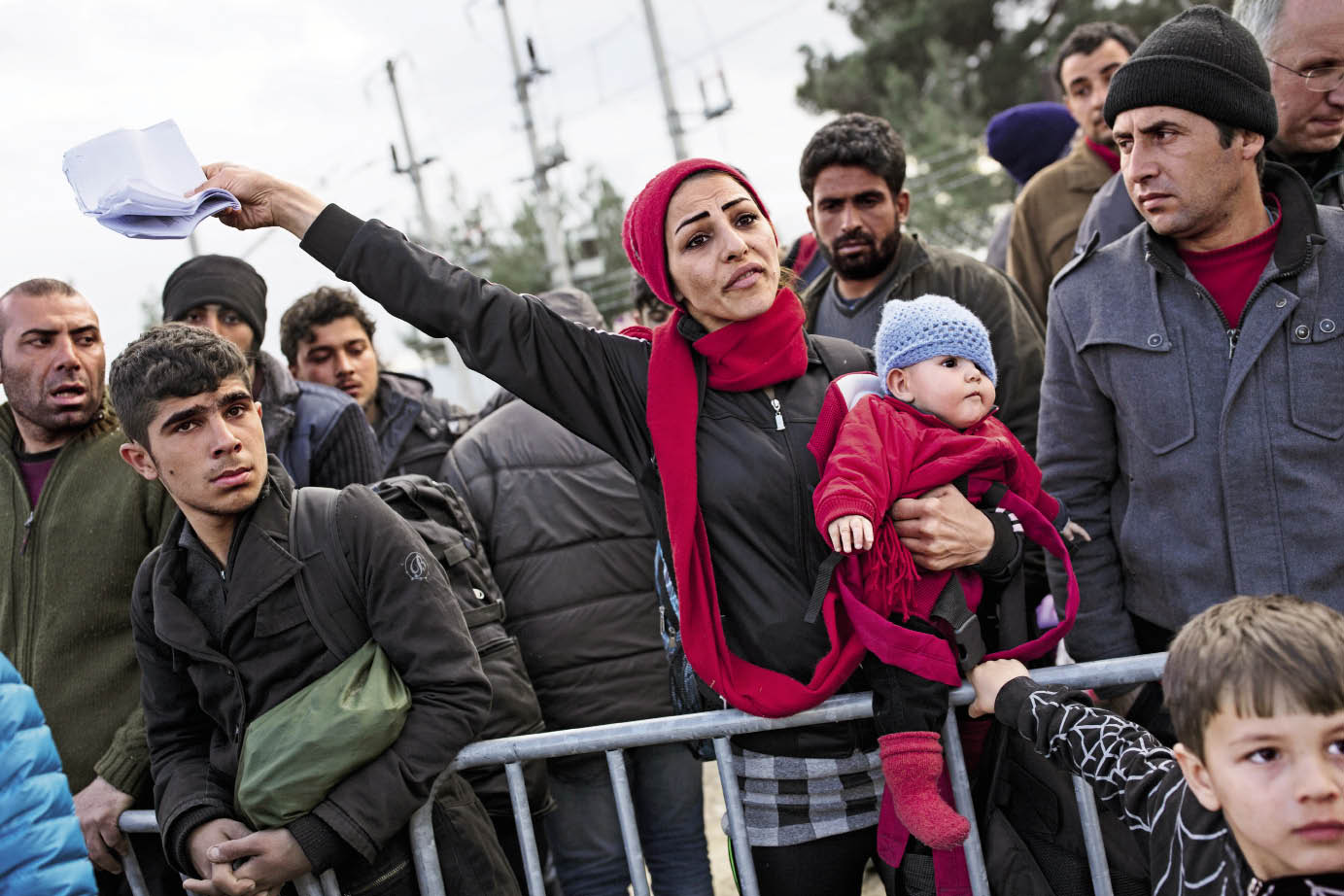By YANG JINGMIN
By YANG JINGMIN
Meanwhile, the number of refugees who return to their homelands is falling, foreboding distant hope of a homecoming for these people. In addition to foreign refugees, 40.8 million people are internally displaced, 3.2 million are seeking asylum, and 10 million are denied any nationality. They are all struggling in an unfurling humanitarian crisis.
Developing Countries Are Major Refugee-hosting Countries
The capacity of the international community to help refugees falls short of the severity of this crisis. Owing to geographical and financial reasons, most émigrés flee to neighboring countries and regions, which are often also less developed. Though the refugee influx to Europe receives more media coverage, the fact is that the continent is far from the largest recipient. As of 2015 developing countries and regions accommodated 86 percent of international refugees under the UNHCR mandate, 5.9 million of them in countries whose populations’ average annual income is under US $5,000. What’s more, the least developed countries provided asylum to 3.6 million refugees or about 25 percent of the global total.

The number of refugees worldwide jumped from 10.4 million in 2011 to 21.3 million in 2015.
For instance, the war-ravaged Democratic Republic of the Congo has been the world’s sixth largest source of refugees for two years in a row, but still receives more than 11,000 people fleeing the bloodshed in neighboring South Sudan. Regions like the DRC, with their feeble economy and unstable political situation, can barely accommodate these desperate people, so many head towards other countries from there. In their countries of origin a functioning government won’t materialize anytime soon, so any attempt to return is deemed precarious or even perilous.
Refugees Not Economic Migrants
While most countries where foreign refugees pour in lack the means to host them, those who have the resources balk due to rife misunderstandings among their people. Media reports, surveys and even certain research reports don’t distinguish refugees from economic migrants, and therefore mislead the public to some extent.
It is widely held, or feared, around the globe that refugees will take jobs and social welfare away from native residents, and seek more rights and benefits in the host country, igniting conflicts and jeopardizing social security. Some governments also worry that protection of foreign refugees will attract more into their countries, eventually depleting their resources.
The slim majority backing the Leave campaign in the Brexit vote in June can be largely attributed to confusion between the EU refugee issue and U.K. immigrants. Refugees are the people who have been forced to cross national boundaries and who cannot return home safely due to armed conflicts or persecution at home. If other countries refuse to take them in, their lives will be threatened. For this reason, people meeting the international standards for refugees are entitled to help from the host country, UNHCR, and other organizations. Migrants, by contrast, move from one place to another not due to life-threatening factors, but for employment, education or family reunion reasons. And they can expect protection by the government in their native countries if they decide to return.
Migration and Terrorism Entwined
Any offense or crime committed by foreign refugees could be easily exploited by demagogues hawking nationalist ideas, and political factions pitting against each other, so inhibiting national governments from taking in these people who so desperately need help. They are even less welcome now that cross-border migration is associated with an influx of terrorists.
It is hard to verify refugees’ criminal records when they arrive in large numbers, and more so when it comes to detecting the real intentions of each one. The protracted screening process, poor conditions at refugee camps, and severe gender imbalances in this group all contribute to psychological problems for certain asylum seekers. This is evidenced by the mass sexual assault by refugees on New Year’s Eve in Cologne, fights and sexual violence at refugee centers in certain countries, and forced prostitution among woman refugees.
In response, the public’s attitude towards foreign refugees is shifting. The PEGIDA (a nationalist, anti-Islam, far-right political movement in Germany) rally on January 9, 2016, attracted 1,700 supporters. And German police have filed at least 817 attacks on refugee shelters since 2015, compared with 199 in 2014 and 18 in 2011. These negative social security issues also put mounting pressure on the open-door policy of Angela Merkel’s government.
In the media reports of terrorist attacks, refugees become the scapegoat of second- and even third-generation immigrants to Europe. Some young descendents of Middle East migrants, frustrated by the West’s failure to prevent the Syria war, head to Syria to join the Jihad, and become brainwashed there. Those of them who later return to stage terrorist attacks can travel freely in the Schengen area, increasing the risks of such incidents. One salient example is the French Jihadist killing of four at a Jewish museum in Brussels in May 2014. He entered Europe via Germany and later staged the carnage in Belgium.

Ten athletes were chosen for a team that represented the world’s refugees at the 2016 Rio Olympic Games.
The growing number of Europeans joining Islamic fighters abroad has alarmed European governments. Data from the International Center for the Study of Radicalization and Political Violence (ICSR), King’s College London, showed that in 2014, 2,000 Europeans were fighting in Syria. By the estimates of their respective national governments, 700 were from France, 500 from the U.K., 300 from Germany, 100 from Netherlands and a certain number from Belgium. They include both men and women, and new Islamic converts as well.
Although the study by terrorism researcher Thomas Hegghammer finds that only one ninth of returning Jihadists may carry out attacks at home, national governments cannot disregard fears of possible strikes by these battle-hardened, brainwashed returnees. And the free travel between most countries in Europe makes this threat a regional one. Such fears are well founded. Salah Abdeslam, a main suspect in the Paris attack last November, is a Belgium-born French national. Similarly the Brussels bombings in March this year that killed 32 were also carried out by its citizens.
China’s Experience
As a signatory of the Convention (1951) and Protocol (1967) Relating to the Status of Refugees, China took in more than 300,000 refugees from neighboring countries in the late 1970s, and successfully integrated them into local communities. These people were offered jobs on farms and in factories, gradually weaning from government aid and realizing autarky. More schools were built in regions hosting these people to accommodate their children, and various training courses were made available to them to boost their employment prospects. What’s more, the Chinese government granted these refugees full citizenship over a span of 10 years, issuing them ID cards and hukou (household registration) certificates. While making domestic laws on the refugee issue, China has earnestly cooperated with UNHCR and the International Organization for Migration (IOM) to arrange assistance for refugees.
This Chinese experience can be shared with countries in Southeast Asia and elsewhere. In the first quarter of 2015 alone 25,000 Rohingya people fled Myanmar. Denied citizenship at home, they were also rejected by Bangladesh across the border. Many took the risk of crossing the Andaman Sea in rickety boats to Southeast Asian countries including Thailand and Malaysia. Due to the insurgency in its predominantly Muslim southern provinces, Thailand refuses to accept these new arrivals on its shore. So does Malaysia, which is already overburdened by international refugees. Malaysian authorities towed the Rohingya boats out of its waters after offering them basic humanitarian aid.
According to UNHCR reports, 750 Rohingya migrants died during the perilous sea journey in 2014 alone. This tragedy highlights the problems in the refugee rescue and aid system of Southeast Asia. National governments in the region stand by their respective policies without bothering to coordinate domestic laws with international ones over the refugee issue. Consequently the execution of international rules and practices is encumbered. Meanwhile, an effective communication mechanism is yet to be established between refugees’ destination country, transit country, and country of origin.
Last year was designated the China-ASEAN Maritime Cooperation Year, and China proposed to open a maritime emergency rescue hotline with ASEAN members. China is willing to share with ASEAN its experience of the management of refugees and illegal immigrants, and to join efforts with them in offshore rescue. These endeavors will advance China-ASEAN cooperation, and testify the efficacy of the Belt and Road Initiative in addressing global issues.
Finding a Solution
The predicament of refugee-hosting countries could be alleviated by admitting or granting refugee status to fewer migrants, and diverting some to other nations. Such methods, however, don’t reduce the total number of refugees worldwide, and may exacerbate the plight these people are facing.
The refugee issue calls for, first of all, humanitarian thinking by all countries and regions concerned. But to reduce the global population of refugees and eventually eradicate this problem once and for all, peace and order must be restored in the countries that force refugees abroad. Marked changes won’t occur in these countries any time soon given the scale of the crisis and the countries’ lack of capacity or resolve of good governance. But that should be the direction of endeavors the international community makes in sustaining world peace and stability and solving the humanitarian crisis of refugees.
Measures should be taken in the following aspects:
1. The Convention (1951) and Protocol (1967) Relating to the Status of Refugees are not binding on all UN members. But the UN can pass resolutions at its General Assembly or Security Council that apply to all member nations. The countries that have not signed the Convention and Protocol may invoke certain common laws on refugee protection when dealing with the refugee crisis.
2. A multi-layered, mutually beneficial cooperative mechanism must be established to encourage individual countries to contribute to offering refugees protection. Once a refugee crisis erupts in a region, all countries in the vicinity are affected. So cooperation is essential between the refugees’ home countries, transit countries, and destination countries, and international and inter-governmental organizations as well. In regions that have established mature regional mutual-aid mechanisms, these apparatuses should lead, coordinate, and regulate moves of regional countries over the refugee issue, working as a bridge between international laws and national acts.
3. The solution lies in reducing refugee numbers. When the conflict in their countries of origin eases, fewer people will be forced to migrate, and the refugee tide will consequently ebb. Once peace is in sight, the diaspora will stream back. To address the root cause of refugees, the UNHCR and IOM should align their actions with the peace process in regions of conflicts, the UN peace-keeping missions, and the development and aid programs of the World Bank and International Monetary Fund.
DR. YANG JINGMIN is an assistant researcher with the World Development Strategy Department of Central Composition & Translation Bureau. She presides over the “international refugee system” research, a project of China’s national social science fund.